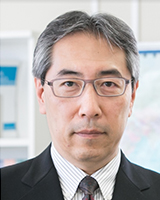
ここからコンテンツです。

In Pursuit of Robots that Act Autonomously to Support Human Activities
Jun Miura

Professor Jun Miura seeks to create service robots that recognize their surrounding circumstances, allowing them to act autonomously to support people's lives. They are not humanoid robots that walk on two legs, whose development was led by Japan, nor are they communication robots that talk with a charming voice and have charming facial expressions. The robot that his research team has so far developed moves on wheels and is not designed for looks. This is the result of prioritizing the function of autonomous operation in the complexity of the real world. Professor Miura was interviewed about his research approach and the application of the robot in the agricultural sector.
Interview and report by Madoka Tainaka
Combining technologies to improve the performance of the robot
"I believe that it is the eyes that are the most important part of a robot. In other words, the ability to view (recognize) the surrounding environment. Based on this, the robot should employ its brain to think (plan) about what action to take and move (control itself). These three steps are the most basic functions that allow the robot to perform different tasks in an environment where humans live," says Professor Jun Miura.
In the past, Japan led the world in industrial robots and produced the world’s first humanoid and communication robots. Japan was always ahead of the game in this field. Regrettably however, it must be said that Japan's robot researchers are now outperformed by overseas competitors. One explanation is that Japan has focused on hardware for control whereas the West, in particular, developed robots with a focus on the brain of the robot. Specifically, they focused on software for recognition and planning, or artificial intelligence (AI). In this sense, the professor's research emphasizes recognition. It is cutting-edge research with the goal of increasing the intelligence of robots.
However, he says that even recognition, which is positioned as the first step, has yet to reach a sufficiently practical level. "Today, autonomous cars are reaching the commercialization phase. Robots are now capable of moving freely. However, it is still difficult to ensure their sound operation in an unknown environment. While recognition accuracy surpasses 90% in the research phase, we will still feel hesitant to immediately introduce autonomous cars in the real world. We will have no choice but to work steadily combining multiple technologies to improve the entire system with a view toward achieving that remaining 10%."
As a consequence, the robots he designs rely on more than a single eye. In addition to the RGB camera, he is combining multiple sensors to determine the positional relationship between objects and people from multiple perspectives. These sensors include a far infrared thermometer for measuring the temperature, a laser distance sensor (with light detection and ranging (LiDAR) technology) for measuring distances and shapes, and a GPS system for accurately identifying position. In addition, machine learning and deep learning are used to discover target patterns and features of objects from a large amount of data, and multiple recognition programs are automatically created and utilized in a combination with them. If the robot still lacks the information it needs to make a decision, it will act autonomously to actively obtain the information it requires.
"Several existing technologies are used together to interpret a complicated physical space. What I think is particularly significant is an approach called sensor fusion. This means making a comprehensive judgment based on a massive amount of collected data. We are combining this with deep learning and other learning algorithms and active sensing, which is the proactive collection of needed information, to improve the recognition performance of the entire system and to create a robot that operates soundly."
Developing robots that move autonomously
Professor Miura uses the research approach above to develop service robots equipped with sensors for recognizing the environment surrounding them so that they can autonomously move to escort and accompany human users. For example, the robots can go shopping together with elderly people. They can guide them to destinations, carry luggage and act as wheelchairs to bring them back home.
"Robots like these need to accurately recognize the circumstances and operate autonomously. For this purpose, we operate robots under different assumed conditions for a long time to solve problems one by one."
For instance, his team developed a system that integrated three-dimensional LiDAR technology with machine learning to distinguish humans from other objects. In the development process, they paid attention to human traits.
"Take the sensing of a town using LiDAR technology for example. Utility poles look like bars. In contrast, the human silhouette is characterized by a rather small head, wide shoulders and tapering towards the legs. We then sliced the human data horizontally in the direction of height, extracted the feature values in each cross-section, and used a machine learning program to automatically investigate what kind of feature values can be combined to distinguish between people and non-humans. By applying this learning program, we were able to discriminate people from LiDAR information in real time."
They also invented a robot designed to recognize objects using deep learning in a room with chairs, a desk, a television set, apples and other items and to pick up and retrieve the item chosen by the user after measuring the distance to the item using LiDAR technology. They also succeeded in creating a robot with multiple sensors that could follow a specific person without losing them.
"As I said earlier, the key to our research is sensor fusion. The accuracy of identification of a specific person can be massively increased by combining multiple factors such as height, color of clothing and the way they walk instead of focusing on a single factor. That enables the robot to follow the person without missing them in a situation where the image of the person is not very discernible due to backlighting."
Furthermore, he and his fellow researchers are working to develop a robot that leverages sensor fusion to draw maps. It is a robot that autonomously collects data using LiDAR technology to draw a map of the route that it has traveled. It is effective for the exploration of unknown places.
"Another advantage of creating a map is that the current whereabouts of the robot can be visually indicated on the map when it is traveling through a place it has passed through before. We have already created a map of the university campus using three-dimensional LiDAR technology. In the future, we will use this technology to create a robot that can move more freely."
Introducing robotics to the agricultural sector prior to full-scale application in society
Professor Miura's various research achievements are starting to be applied in the agricultural sector. For example, he is using deep learning to analyze information collected by robots in horticultural facilities, and is working to predict the cultivation environment and yield based on this information.
He explains, "One robot has already been commercialized. It completely automates the processes from the sorting to the binding of perilla leaves. It was released by Sinfonia Technology Co., Ltd. this past spring. It incorporates an image recognition system based on deep learning to determine the size of leaves and whether they conform to standards. It achieves a level of accuracy that is comparable with highly skilled workers." However he is also willing to admit that "their applications in society are still limited."
To address this issue, he is taking another approach. This is the development of robots that can collaborate with humans.
"One example is a robot we have developed which is designed to ask humans when it is unable to easily make a decision. When it is ordered to fetch a cup from another room, the robot observes the shapes, colors and materials of multiple cups and autonomously figures out a question to get an appropriate answer. If there is more than one cup with a similar color and shape, it will ask the person what material is desired to ensure that it will carry the right cup to them."
In a sense, it may be seen as a way of using humans as a sensor for collecting data. "We will use anything we can use in order to somehow create robots that will work in society." His earnest dream is gradually coming closer to reality.
Reporter's Note
Jun Miura loved railways as a child and chose to study mechanical engineering in university. This was at a time when robot research was expanding. Gradually, he became interested in intelligent robots. As a graduate student, he studied computer science.
After getting a job, I began fully studying image recognition under the guidance of Prof. Yoshiaki Shirai at Osaka University. At Carnegie Mellon University, I was hugely inspired by Prof. Takeo Kanade and Prof. Katsushi Ikeuchi. They are all pioneers in computer vision.Then, I realized that robots would be meaningless if they did not move," reminisces the professor. He continues, saying that while moving robots involves far more difficult problems that must be resolved they can do more and support people's lives. We hope to see reliable robots like these become a reality.
自律的に動き、人の活動を支援するロボットを
三浦純教授がめざすのは、周囲の状況を認識して自律的に動き、人々の暮らしを支援するサービスロボットの実現である。それらは、日本が牽引した二足歩行の人型ロボットでも、愛嬌のある声と表情で話しかけるコミュニケーションロボットでもない。三浦教授らが手がける現状のロボットは車輪で動く無骨な姿をしているが、それは複雑な現実世界を認識し、自律的に動くことに重きを置いてきた結果だ。三浦教授の研究アプローチと農業分野への応用などについて聞いた。
技術を組み合わせてロボットの性能を上げる
「私がロボットで一番重要だと思うのは、ロボットの眼です。つまり周囲の環境をしっかり見る(認識)ということ。そのうえで、自らの頭で考え(計画)て、動く(制御)こと。この三つのステップが、人間の暮らす環境でロボットがさまざまなタスクをこなす際に、もっとも基本となる機能だと思います」と、三浦純教授は語る。
かつての日本は、産業用ロボット業界をリードし、その後も世界に先駆けてヒューマノイドロボットやコミュニケーションロボットを世に送り出すなど、ロボット分野の先頭をつねに走ってきた。しかし残念ながら、現在の日本のロボット研究は海外勢に押され気味と言わざるを得ない。その一つの原因は、制御を担うハードウェアを重視してきた日本に対し、とくに欧米では認識・計画を司るソフトウェア、すなわちロボットの頭脳(AI)に重きを置き、開発を進めてきた点にある。そうした意味で、三浦教授の研究は後者の「認識」をメインにしており、ロボットの知能化をめざす先端の取り組みと言える。
しかし、最初のステップの認識すらも、まだ十分な実用段階にはないと三浦教授は言う。
「いまや自動運転車が実用段階に入りつつあるように、ロボットはかなり自在に動けるようになってきました。しかし、未知の環境下で確実に動くのはまだまだ難しい。研究段階で認識精度が9割を超えたと言われても、いますぐに自動運転車を実社会には受け入れる気にはなりませんよね。残りの1割の穴を埋めるために、システム全体で改良を重ね、いくつもの技術を組み合わせながら地道に取り組むほかないと思っています」
そうしたことから、三浦教授が手がけるロボットの「眼」も一つではない。RGBカメラに加え、温度を測る遠赤外線温度計や距離や形状を調べるレーザー距離センサ(LiDAR=Light Detection And Ranging)、正確な位置を知るためのGPSなど、複数のセンサを組み合わせて、モノや人との位置関係を多面的に把握する。さらに、機械学習や深層学習を用いて、大量のデータから対象のパターンや特徴量を見出し、認識プログラムを自動で生成して、それらを複数組み合わせて使う。それでも判断材料が足りなければ、ロボットが自らアクションを起こすことで欲しい情報を能動的に取りに行く、といった具合だ。
「現実の複雑な空間を認識するために、すでにある技術をいくつも組み合わせて使うわけですね。なかでも私が重要だと考えるのが、多数のデータを集めて総合的に判断するセンサフュージョンというアプローチです。そこに、深層学習などの学習アルゴリズムや、欲しい情報を自ら取りに行くアクティブセンシングを組み合わせて、システム全体で認識性能を高め、確実に動くロボットをつくろうとしているのです」
自律的に移動するロボットの開発
こうした研究アプローチの下、三浦教授がめざすロボットとは、センサで周囲の環境を認識し、自律的に移動しながら、案内や付き添いをするサービスロボットである。たとえば高齢者と一緒に買い物に出かけて道案内をし、荷物を持ってついてきて、帰りには車椅子となって人を乗せて自宅まで送り届けてくれるようなロボットだ。
「このようなロボットには、状況をしっかり認識して自律的に動くことが求められます。そのために我々は、想定されるさまざまな条件下でロボットを長時間動かしながら、一つずつ課題をクリアしています」
たとえば、人とそれ以外のものを区別するために、三浦教授らは三次元LiDARと機械学習を組み合わせたシステムを開発した。このときに着目したのが、「人らしさ」の特徴だという。
「たとえば、LiDARで街の様子をセンシングすると、電信柱は棒状に見えるのに対して、人の頭はやや小さく、肩で広がって、また足に向かって細くなるという特徴を備えています。そこで人のデータを高さ方向に水平に輪切りにし、それぞれの断面における特徴量を抽出して、どういう特徴量を組み合わせれば人と人以外を判別できるかを、機械学習プログラムを使って自動的に調べました。この学習プログラムを適用することで、LiDARの情報からリアルタイムに人を判別できるようになりました」
そのほかにも、椅子や机、テレビ、リンゴなどさまざまなモノが置かれた部屋で、ロボットが深層学習を使って物体を認識すると同時に、その物体までの距離をLiDARで測ることにより、所望のものを手に取り持ってくるロボットも開発。さらには、複数のセンサを活用して、特定の人を見失うことなく追随して動くロボットの開発にも成功している。
「先述したように、我々の研究の肝はセンサフュージョンにあります。たとえば、特定の人を見分ける際に、身長、服の色、歩き方など、一つの要素だけに注目するのではなく、これらを複数組み合わせることで、判別の精度を格段に上げることができます。それによって、逆光で映像が判別しづらい状況でも、特定の人を見失うことなくついていくことができるというわけです」
さらに、三浦教授らは、センサフュージョンを活用して、地図をつくるロボットの開発も進めている。これは、LiDARを使い、ロボットが自ら情報を集めながら、移動した経路を地図として描くというシステムで、未知の場所の探索に有効だ。
「地図をつくるもう一つの利点は、再び同じ場所をロボットが通った際に、現在どの場所を移動しているのかを、地図上にプロットして可視化できる点にあります。すでに三次元LiDARを使って、大学のキャンパス構内の地図を作成していて、今後はこの技術を使い、より自在に動けるロボットを実現していきたいと考えています」
農業分野を手始めに社会実装へ
三浦教授のこうしたさまざまな研究成果は、農業分野で応用され始めている。たとえば、ロボットが園芸施設内で集めた情報を深層学習で解析し、これをもとに栽培環境や収量などを予測する取り組みを進めている。
「すでに商品化されたロボットもあります。これは、大葉の選別から結束までを完全自動化したロボットで、今春、シンフォニアテクノロジー株式会社から販売されました。サイズの判別や良否の判定には、深層学習による画像認識システムを採用して、これにより熟練の人と変わらない精度を出すことができるようになりました。もっとも、実社会への応用はまだ限定的なのが実情です」と三浦教授は課題を語る。
そこでもう一つ別のアプローチとして三浦教授が進めているのが、人間と協調作業を行うロボットの開発だ。
「一例として、ロボットが判断に迷ったときに、人間に尋ねるロボットを開発しました。別室にあるコップを取ってくるようにロボットにお願いすると、ロボットは複数のカップの形状や色、素材を見て、どのような質問をすれば正しい答えが得られるのかを自ら考えます。色や形状が似たカップが複数あれば、『どんな素材のコップですか?』と人に尋ねて、無事に正解のコップを持ってくることができるというシステムです」
これも、ある意味、人間を情報を得るための一つのセンサとして使うやり方と言えるかもしれない。「使えるものはなんでも使い、とにかく現実社会で動くロボットをつくりたい」。その三浦教授の切実な願いは、一歩ずつ実現に近づきつつある。
(取材・文=田井中 麻都佳)
取材後記
幼い頃から鉄道が好きで、大学では機械系の学科に進学した三浦教授。ちょうどロボット研究が盛り上がりを見せていた頃だが、次第にロボットの知能化に興味を持つようになり、大学院から情報系に転向したという。
「就職後は、大阪大学の白井良明先生の下で画像認識を本格的に手がけるようになり、カーネギー・メロン大学では金出武雄先生、池内克史先生から多大な影響を受けました。これらコンピュータビジョンの草分けの先生方とのかかわりのなかで実感したのは、やはりロボットは動かなければ意味がない、ということでした」と三浦教授。動くことで解くべき問題は格段に難しくなるが、できることも増え、人々の暮らしを支えることができるようになる、と言う。そのような頼れるロボットの実現に期待しています!
Researcher Profile

Jun Miura
Jun Miura received Dr. Eng. degree in Information Engineering from the University of Tokyo in 1989. From 1989 to 2007, he had been with Department of Mechanical Engineering, Osaka University, first as a Research Associate and later as an Associate Professor. In 2007, he became a Professor of Department of Computer Science and Engineering, Toyohashi University of Technology.
Reporter Profile

Madoka Tainaka
Editor and writer. Former committee member on the Ministry of Education, Culture, Sports, Science and Technology Council for Science and Technology, Information Science Technology Committee and editor at NII Today, a publication from the National Institute of Informatics. She interviews researchers at universities and businesses, produces content for executives, and also plans, edits, and writes books.
ここでコンテンツ終わりです。
